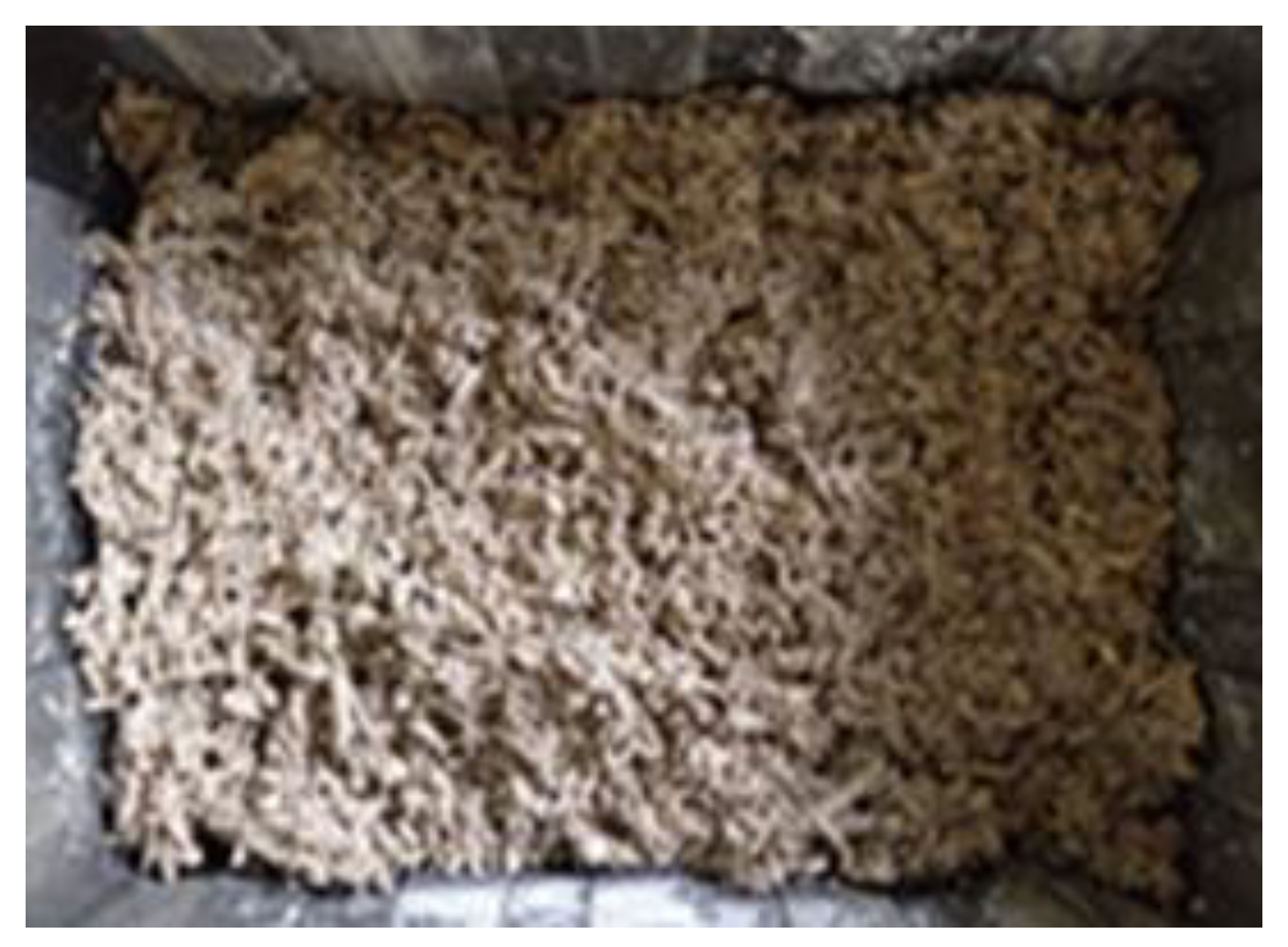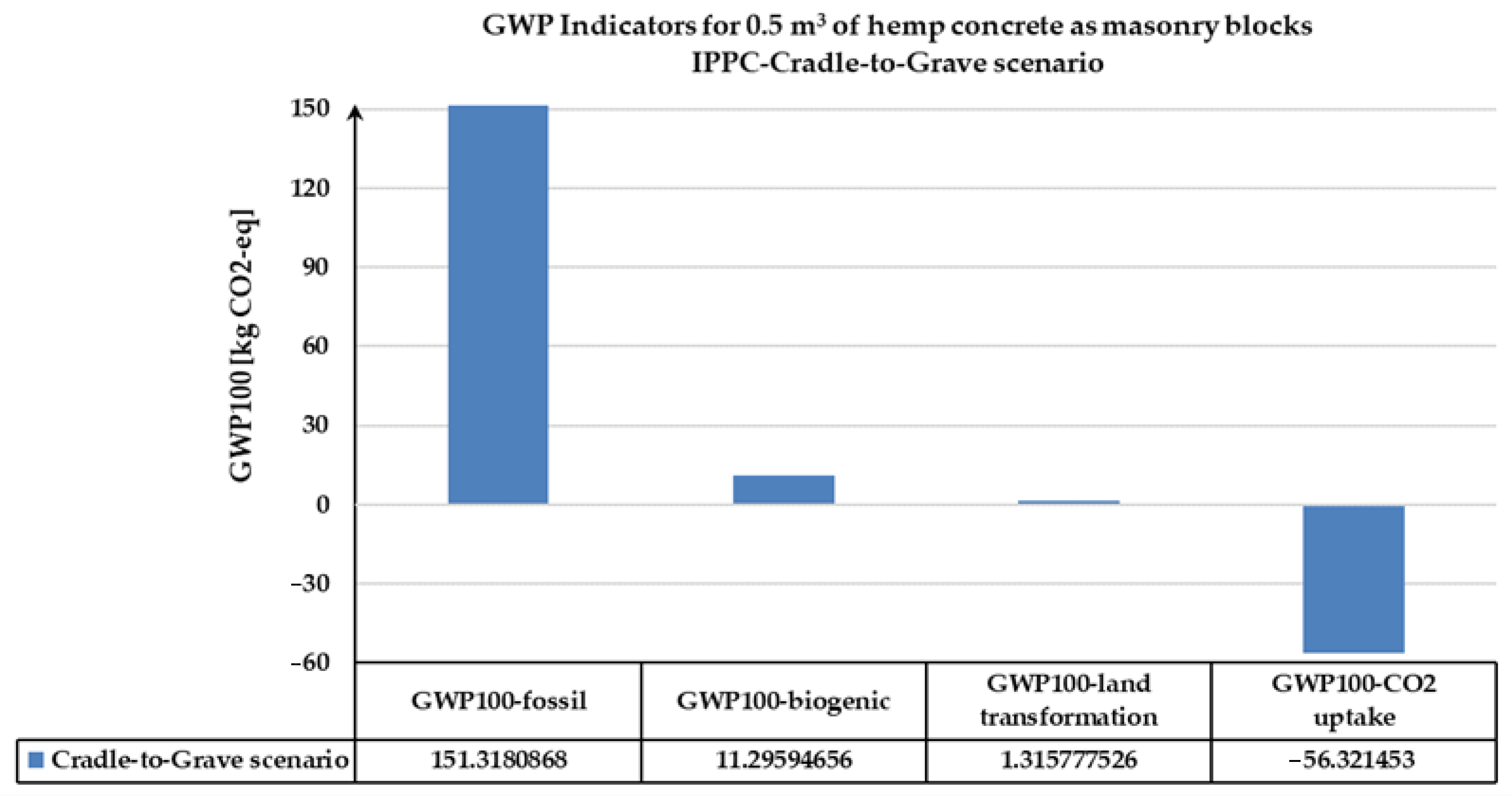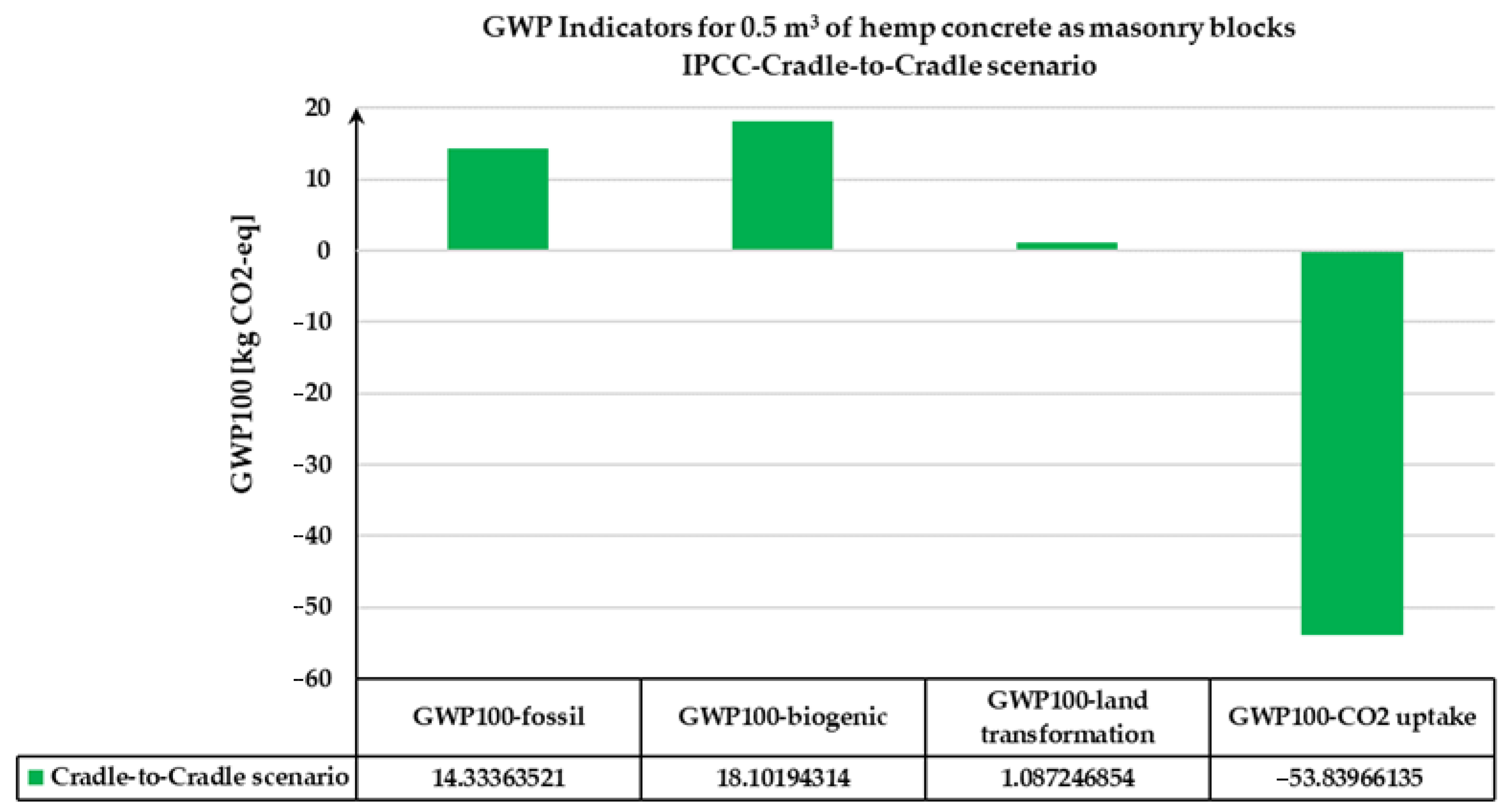Carbon Footprint Assessment: Case Studies for Hemp-Based Eco-Concrete Masonry Blocks
Abstract
:1. Introduction
2. Materials and Methods
2.1. Description of the Masonry Blocks Made of Hemp Concrete
2.2. Carbon Footprint Assessment for Hemp-Based Eco-Concrete Masonry Blocks
- Cradle-to-Grave-scenario LCA from the production of hemp concrete to the end of the use period [34]. The Cradle-to-Grave scenario ends when the building, after the standard period of operation (100 years), is demolished, and the resulting waste is deposited at a landfill.
- Cradle-to-Cradle-scenario LCA from the production of hemp concrete to the end of the period of use, considering the recycling and reuse of newly obtained raw materials [33]. The Cradle-to-Cradle scenario means that the building, after its normal service life (100 years), is dismantled and the hemp concrete is reused as a recycled product (e.g., as recycled aggregates) in a new construction.
- IPCC 2021 GWP100 V1.02 method—a global warming potential analyzing GWP100-fossil; GWP100-biogenic; GWP100-land transformation; and GWP100-CO2 uptake [35];
- ReCiPe 2016 Midpoint (H) V1.08 method analyzing the potential pollutants with an effect on reducing the ozone layer, changing the soil structure, human health, diminishing mineral resources, consumption and water pollution from marine or continental ecosystems, land use, etc. [36].
- Step 1—The hemp shreds are hydrated in a sodium silicate–water solution for 24 h;
- Step 2—The hydrated hemp shreds are mixed with a calcium oxide–water solution and a cement–water solution;
- Step 3—The composition is poured into a mold and pressed.
- Sodium silicate (5.625 kg) mixed with water (55 kg);
- Calcium oxide (40 kg) mixed with water (120 kg) as a mineral binder;
- Cement (40 kg) mixed with water (20 kg) as a hydraulic mineral binder;
- Hemp shredding (55 kg), the ecological base material.
- ➢
- Case Study 1 was carried out applying the IPCC 2021 GWP100 V1.02 methodology;
- ➢
- Case Study 2 was conducted applying the ReCiPe 2016 Midpoint (H) V1.08 methodology.
3. Results
3.1. Case Study 1—The Results Obtained in the Assessment of Environmental Impact Indicators Applying the IPCC Methodology
3.2. Case Study 2—The Results Obtained in the Assessment of Environmental Impact Indicators Applying the ReCiPe Methodology
- Silicate–water solution exhibits moderate impacts (under 30%) in categories like ionizing radiation and various ecotoxicity measures;
- Calcium hydroxide shows elevated impacts (over 50%) in several critical categories, including global warming, ionizing radiation, fine particle formation, and ecotoxicity;
- Cement–water solution has significant impacts on global warming and ozone formation, though it does not reach the highest thresholds (under 30%);
- Hemp shows considerable impacts (over 70%) in water consumption, marine eutrophication, and land use. These high values indicate the need for sustainable practices in hemp cultivation;
- Low-voltage electricity consumption has the lowest impact (under 1.5%) across all environmental categories considered, indicating that it is the least environmentally detrimental.
- Damage to human life from midpoint indicators;
- Damage to ecosystems from midpoint indicators;
- Damage to resources availability from midpoint indicators.
4. Discussion
5. Conclusions
- Hemp concrete has been used successfully in various multi-purpose buildings and renovation projects. Solutions for masonry blocks based on hemp concrete, with their proven thermo-mechanical performances, can expand the range of applications. Its versatility and adaptability demonstrate the potential of this eco-sustainable material for widespread use in the construction industry.
- Masonry blocks made of hemp concrete have low values of compressive resistance, which, however, ensure shape stability and maneuverability during assembly. These characteristics, combined with the reasonable thermal conductivity values, constitute an advantage for their use as filling elements of the thermal insulation layer in the wall structure.
- Hemp concrete has a significantly lower carbon footprint compared to traditional concrete materials.
- Hemp crops absorb carbon dioxide, making hemp a carbon-negative material, and its use as a building material has a positive influence by reducing GHG emissions and reaching the decarbonization target in the construction sector.
- The LCA research emphasized that, for 0.5 m3 of hemp concrete used in masonry blocks, there are CO2 uptake values of −53.8397 [kg CO2-eq] in the Cradle-to-Cradle scenario and of −56.3215 [kg CO2-eq] in the Cradle-to-Grave scenario.
- Recycling and the use of shredded hemp in masonry blocks have a significant contribution, and positively influence the balance in CO2 emissions, according to the GWP indicators.
- According to the Cradle-to-Cradle analysis, using the IPCC methodology, it was found that recycling hemp concrete masonry blocks at the end of their lifespan, for a functional unit of 0.5 m3, results in GHG emissions of 33.228 [kg CO2-eq]. Additionally, the blocks have the capacity to sequester carbon dioxide, with an uptake value of −53.8397 [kg CO2-eq]. Therefore, the overall GHG balance is negative, totaling approx. −20.3168 [kg CO2-eq].
- Balancing the indicators’ values, it is observed that for the Cradle-to-Cradle scenario the results show a negative carbon footprint of −20.3168 [kg CO2-eq], and in the Cradle-to-Grave scenario the result is a positive carbon footprint of 107.6084 [kg CO2-eq].
- The environmental evaluation of the ReCiPe method offers both midpoint and endpoint indicators. This dual-level approach affords a detailed analysis (midpoints) or a more simplified, overarching view of environmental impacts (endpoints). The method targets environmental impact assessment to convert LCIA goals to a limited number of impact scores at a midpoint or endpoint level.
- The LCIA analyses in the ReCiPe method reflect a decreased damage to human health, natural resources, and biodiversity when hemp concrete is used for masonry blocks.
- Economic circularity in the construction sector is possible if capacities are developed for the dismantling and recycling of hemp concrete construction elements after the end of the building’s life, so that at least 95% of the materials are reused (as aggregates for example) to obtain new eco-sustainable hemp concrete masonry blocks.
- Hemp concrete is emerging as a viable solution for sustainable construction. As the environmental impact of traditional concrete becomes apparent, innovative alternatives such as hemp concrete in various forms of use are gaining importance. Its environmental benefits and structural advantages place hemp concrete in the category of materials that can bring changes in the practices and principles in the construction industry. Using hemp concrete can help reduce the carbon footprint, creating healthier environments for future generations. Multidisciplinary research and collaborations are crucial to the widespread adoption of hemp concrete and the achievement of a sustainable built infrastructure.
Author Contributions
Funding
Data Availability Statement
Conflicts of Interest
References
- European Climate Law. Available online: https://climate.ec.europa.eu/eu-action/european-climate-law_en (accessed on 12 August 2024).
- Land Use. Land Use Change and Forestry (LULUCF) Regulation. Available online: https://www.europarl.europa.eu/legislative-train/package-fit-for-55/file-lulucf-revision (accessed on 12 August 2024).
- Crippa, M.; Guizzardi, D.; Pagani, F.; Banja, M.; Muntean, M.; Schaaf, E.; Becker, W.; Monforti-Ferrario, F.; Quadrelli, R.; Risquez Martin, A.; et al. GHG Emissions of All World Countries; Publications Office of the European Union: Luxembourg, 2023; p. JRC134504. [Google Scholar] [CrossRef]
- EDGAR (Emissions Database for Global Atmospheric Research) Community GHG Database (a Collaboration between the European Commission, Joint Research Centre (JRC), the International Energy Agency (IEA), and Comprising IEA-EDGAR CO2, EDGAR CH4, EDGAR N2O, EDGAR F-GASES Version 8.0; European Commission: Brussels, Belgium, 2023.
- Intergovernmental Panel on Climate Change (IPCC). 2022: Emissions Trends and Drivers. In IPCC, 2022: Climate Change 2022: Mitigation of Climate Change. Contribution of Working Group III to the Sixth Assessment Report of the Intergovernmental Panel on Climate Change (PDF); Cambridge University Press: Cambridge, UK, 2022. [Google Scholar] [CrossRef]
- Available online: https://www.unep.org/resources/report/building-materials-and-climate-constructing-new-future (accessed on 12 August 2024).
- Available online: https://www.architecture2030.org/why-the-built-environment/#:~:text=Buildings%20generate%20nearly%2040%25%20of,for%20an%20additional%2011%25%20annually (accessed on 14 August 2024).
- Hudisteanu, I.; Taranu, N.; Isopescu, D.N.; Bejan, L.; Axinte, A.; Ungureanu, D. Improving the mechanical properties of composite laminates through the suitable selection of the corresponding materials and configurations. Rom. J. Mater. 2017, 47, 252–266. [Google Scholar]
- Hudisteanu, I.; Taranu, N.; Isopescu, D.N.; Entuc, I.-S.; Oprisan, G.; Ungureanu, D. Numerical analysis of intralaminar damage evolution on various composite laminates. IOP Conf. Ser. Mater. Sci. Eng. 2018, 400, 042031. [Google Scholar] [CrossRef]
- Ungureanu, D.; Ţăranu, N.; Isopescu, D.-N.; Lupăşteanu, V.; Scutaru, M.-C.; Hudişteanu, I. Failure particularities of adhesively bonded joints between pultruded GFRP composite profiles. IOP Conf. Ser. Mater. Sci. Eng. 2018, 400, 032011. [Google Scholar] [CrossRef]
- Adam, L.; Isopescu, D.N. Physico-Mechanical Properties Investigation of Hempcrete. J. Appl. Life Sci. Environ. 2022, 55, 75–84. [Google Scholar] [CrossRef]
- Adam, L.; Isopescu, D.N.; Lepadatu, D. Experimental investigation of parameters influencing mechanical properties of hemp concretes using design of experiment method. IOP Conf. Ser. Mater. Sci. Eng. 2023, 1283, 012001. [Google Scholar] [CrossRef]
- Magwood, C. Essential Hempcrete Construction: The Complete Step-by-Step Guide (Sustainable Building Essentials Series, 1); New Society Publishers: Gabriola, BC, Canada, 2016; ISBN 13978-0865718197. [Google Scholar]
- A New Building in France Makes the Case for Hemp to Replace Concrete. 2021. Available online: https://www.fastcompany.com/90706461/a-new-building-in-france-makes-the-case-for-hemp-to-replace-concrete (accessed on 14 August 2024).
- Available online: https://www.ubm-development.com/magazin/en/hempcrete-is-making-waves/ (accessed on 14 August 2024).
- Eco-Friendly, Hemp-Based Concrete Blocks Provide Sustainable Alternative. 2024. Available online: https://san.com/cc/eco-friendly-hemp-based-concrete-blocks-provide-sustainable-alternative/ (accessed on 14 August 2024).
- Ailenei, E.C.; Ionesi, S.D.; Dulgheriu, I.; Loghin, M.C.; Isopescu, D.N.; Maxineasa, S.G.; Baciu, I.-R. New Waste-Based Composite Material for Construction Applications. Materials 2021, 14, 6079. [Google Scholar] [CrossRef] [PubMed]
- Haik, R.; Peled, A.; Meir, A.I. Lime Hempcrete Composites Based on Unfired Binders. A Review. Circ. Econ. Sustain. 2024, 1–11. [Google Scholar] [CrossRef]
- Jami, T.; Karade, S.R.; Singh, L.P. A review of the properties of hemp concrete for green building applications. J. Clean. Prod. 2019, 239, 117852. [Google Scholar] [CrossRef]
- Arrigoni, A. Life Cycle Assessment of Natural Building Materials: The Role of Carbonation, Mixture Components and Transport in the Environmental Impacts of Hempcrete Blocks. J. Clean. Prod. 2017, 149, 1051–1061. [Google Scholar] [CrossRef]
- Arehart, J. On the Theoretical Carbon Storage and Carbon Sequestration Potential of Hempcrete. J. Clean. Prod. 2020, 266, 121846. [Google Scholar] [CrossRef]
- Flahiff, D. Hemcrete®: Carbon Negative Hemp Walls. 2009. Available online: https://inhabitat.com/hemcrete-carbon-negative-hemp-walls-7x-stronger-than-concrete/ (accessed on 15 August 2024).
- Vosper, J. The Role of Industrial Hemp in Carbon Farming. Available online: https://www.aph.gov.au/documentstore.ashx?id=ae6e9b56-1d34-4ed3-9851-2b3bf0b6eb4f (accessed on 15 August 2024).
- Zampori, L.; Dotelli, G.; Vernelli, V. Life Cycle Assessment of Hemp Cultivation and Use of Hemp-Based Thermal Insulator Materials in Buildings. Environ. Sci. Technol. 2013, 47, 7413–7420. [Google Scholar] [CrossRef] [PubMed]
- Tanta, A.; Kanwar, V.S. Environmental Assessment of Hemp Concrete over Carbon Emissions. Int. J. Civ. Eng. 2023, 10, 65–73. [Google Scholar] [CrossRef]
- Campiglia, E.; Gobbi, L.; Marucci, A.; Rapa, M.; Ruggieri, R.; Vinci, G. Hemp Seed Production: Environmental Impacts of Cannabis sativa L. Agronomic Practices by Life Cycle Assessment (LCA) and Carbon Footprint Methodologies. Sustainability 2020, 12, 6570. [Google Scholar] [CrossRef]
- Scrucca, F.; Ingrao, C.; Maalouf, C.; Moussa, T.; Polidori, G.; Messineo, A.; Arcidiacono, C.; Asdrubali, F. Energy and carbon footprint assessment of production of hemp hurds for application in buildings. Environ. Impact Assess. Rev. 2020, 84, 106417. [Google Scholar] [CrossRef]
- Kemda, M.M.; Marchi, M.; Neri, E.; Marchettini, N.; Niccolucci, V. Environmental impact assessment of hemp cultivation and its seed-based food products. Front. Environ. Sci. 2024, 12, 1342330. [Google Scholar] [CrossRef]
- SimaPro 9.5.0.2. Available online: https://simapro.com/wp-content/uploads/2023/07/FullUpdateInstructionsToSimaPro950.pdf (accessed on 20 July 2024).
- ISO 14040:2006(en); Environmental Management—Life Cycle Assessment—Principles and Framework. International Organization for Standardization: Geneva, Switzerland, 2006. Available online: https://www.iso.org/obp/ui#iso:std:iso:14040:ed-2:v1:en (accessed on 14 August 2024).
- ISO 14044:2006/Amd 2:2020; Environmental management—Life Cycle Assessment—Requirements and Guidelines. International Organization for Standardization: Geneva, Switzerland, 2006. Available online: https://www.iso.org/standard/76122.html (accessed on 14 August 2024).
- EN 1996-1-1; Eurocode 6: Design of Masonry Structures—Part 1-1: General Rules for Reinforced and Unreinforced Masonry Structures. International Organization for Standardization: Geneva, Switzerland, 2005.
- Sustainability Guide Cradle-to-Cradle Assessment [Online]. Available online: https://sustainabilityguide.eu/methods/cradle-to-cradle/ (accessed on 8 August 2024).
- European Environment Agency. Cradle-to-Grave Assessment. [Online]. Available online: https://www.eea.europa.eu/help/glossary/eea-glossary/cradle-to-grave (accessed on 12 August 2024).
- Available online: https://support.simapro.com/s/article/biogenic-carbon-dioxide-and-biogenic-methane-in-IPCC-methods (accessed on 22 July 2024).
- Available online: https://support.simapro.com/s/article/What-does-the-acronym-ReCiPe-mean (accessed on 10 August 2024).
- Bodoga, A.; Nistorac, A.; Loghin, M.C.; Isopescu, D.N. Environmental Impact of Footwear Using Life Cycle Assessment—Case Study of Professional Footwear. Sustainability 2024, 16, 6094. [Google Scholar] [CrossRef]
- ©2024 The Intergovernmental Panel on Climate Change. Available online: https://www.ipcc.ch/report/renewable-energy-sources-and-climate-change-mitigation/methodology/ (accessed on 26 August 2024).
- LCIA: The ReCiPe Model. Available online: https://www.rivm.nl/en/life-cycle-assessment-lca/recipe (accessed on 27 August 2024).








| No. | Materials | Mass |
|---|---|---|
| [kg] | ||
| 1 | Hemp shredding | 110 |
| 2 | Lime | 80 |
| 3 | Portland cement 42.5 R | 80 |
| 4 | Water | 390 |
| 6 | Sodium silicate Na2SiO3 | 11.25 |
| No. | Properties | U.M. | Values |
|---|---|---|---|
| 1 | Dimensions—L × l × h | mm | 570 × 200 × 230 |
| 2 | Block weight | kg | 13.20 |
| 3 | Compressive strength of the block—fb | N/mm2 | 0.2683 |
| 4 | Characteristic compressive strength of masonry—fk fk = K(fb)0.7(fm)0.3 where K = 0.7 (acc. to [33]) | N/mm2 | 0.556 |
| 5 | Average thermal conductivity of the block—λechiv | W/mK | 0.2661 |
| No. Crt. | Endpoint Impact Indicators LCIA-ReCiPe Method | Midpoint Impact Indicators LCIA-ReCiPe Method |
|---|---|---|
| 1 | Damage to human life | Global warming |
| Stratospheric ozone depletion | ||
| Ionizing radiation | ||
| Ozone formation, human health | ||
| Formation of fine particles | ||
| Human carcinogenic toxicity | ||
| Human non-carcinogenic toxicity | ||
| Water consumption | ||
| 2 | Damage to ecosystems | Ozone formation, terrestrial ecosystems |
| Terrestrial acidification | ||
| Eutrophication of fresh water | ||
| Marine eutrophication | ||
| Terrestrial ecotoxicity | ||
| Ecotoxicity of fresh water | ||
| Marine ecotoxicity | ||
| Land use | ||
| 3 | Damage to resources availability | Lack of mineral resources |
| Lack of fossil resources |
Disclaimer/Publisher’s Note: The statements, opinions and data contained in all publications are solely those of the individual author(s) and contributor(s) and not of MDPI and/or the editor(s). MDPI and/or the editor(s) disclaim responsibility for any injury to people or property resulting from any ideas, methods, instructions or products referred to in the content. |
© 2024 by the authors. Licensee MDPI, Basel, Switzerland. This article is an open access article distributed under the terms and conditions of the Creative Commons Attribution (CC BY) license (https://creativecommons.org/licenses/by/4.0/).
Share and Cite
Isopescu, D.N.; Adam, L.; Nistorac, A.; Bodoga, A. Carbon Footprint Assessment: Case Studies for Hemp-Based Eco-Concrete Masonry Blocks. Buildings 2024, 14, 3150. https://doi.org/10.3390/buildings14103150
Isopescu DN, Adam L, Nistorac A, Bodoga A. Carbon Footprint Assessment: Case Studies for Hemp-Based Eco-Concrete Masonry Blocks. Buildings. 2024; 14(10):3150. https://doi.org/10.3390/buildings14103150
Chicago/Turabian StyleIsopescu, Dorina Nicolina, Laurentiu Adam, Andreea Nistorac, and Alexandra Bodoga. 2024. "Carbon Footprint Assessment: Case Studies for Hemp-Based Eco-Concrete Masonry Blocks" Buildings 14, no. 10: 3150. https://doi.org/10.3390/buildings14103150
APA StyleIsopescu, D. N., Adam, L., Nistorac, A., & Bodoga, A. (2024). Carbon Footprint Assessment: Case Studies for Hemp-Based Eco-Concrete Masonry Blocks. Buildings, 14(10), 3150. https://doi.org/10.3390/buildings14103150








